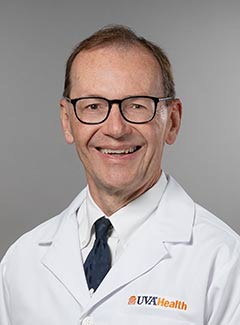
Paul Grabb, MD, is a pediatric neurosurgeon at UVA Health Children’s. In addition to performing surgery, he also works with families and referring providers to find optimal solutions for children with neurological needs. Pediatric neurosurgery can offer help for a wide range of concerns, including brain tumors, epilepsy, and traumatic injury.
In every situation, Grabb works to form relationships that engender trust and allow him to identify and ease any anxieties the patient, or their family, may be feeling.
We talked to him about what principles shape his practice and what he wants providers to know about consulting with him regarding pediatric neurosurgery at UVA Health Children’s.
What made you decide to focus on pediatric neurosurgery?
My fascination with the nervous system and the amazing resiliency of children to come through intracranial operations drew me into pediatric neurosurgery.
Even though I am a specialist, an awareness of “general” medical care is still very important. I enjoy being able to explain the rare and bizarre, whether to families or colleagues. And in circumstances where surgical intervention is warranted, I appreciate the privilege to be able to perform the operations.
How can pediatricians help with the early detection and diagnosis of neurological concerns?
In reference to pediatric neurosurgical issues, referring providers are the front line for screening and detection. For neonates and infants, a “good ol’ fashioned” physical examination that examines the head shape, size, fontanel, neurological examination, and an inspection of the midline skin from occiput to gluteal crease will pick up many neurosurgical concerns.
For older children, listening to their complaints coupled with a neurological examination often is enough to trigger whether imaging (MRI, CT, or X-rays) is warranted and consider a referral.
What’s something about pediatric neurosurgery you wish every provider knew?
Pediatric neurosurgeons are also fully trained in adult neurosurgery. We are also skilled at reading MRIs and CT scans. We can help make sense of dictated radiology reports that create confusion or anxiety by reviewing the actual images.
When should providers refer their patients to your program?
Anytime they have a concern for a potential neurosurgical issue, we invite referring doctors to contact us. Many new referrals involve incidental findings on imaging. And most of these incidental findings are of no risk or concern to the patient.
Hence, while we are happy to see anybody with a potential neurosurgical issue, some families may not be happy to take off work, miss school, and drive hours only to have us tell them that there is nothing to worry about.
We are happy to review imaging and provide feedback to the referring doctors before having a family travel to see us.
What’s your approach to working with providers who refer to you?
When we see a patient, we will generate a note in our EMR. We electronically send a copy back to the referring doctor if one is listed by the family. If a provider needs more information, they are always welcome to call us.
How do you handle meeting a newly referred patient?
I always try to put the parents and/or child at ease with conversation. We may talk about a favorite hobby, class, sport, or place during the examination. That also gives me a sense of what the child likes to do and how that may be impacted by either the potential disease process or recovery from any surgical intervention.